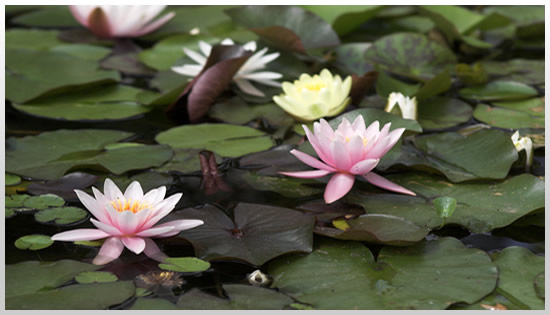WATER LILIES AND AQUATIC GARDENS

It is important to place water lilies and other aquatic plants at their preferred depth. Hardy water lilies need 20 to 30 cm (8 to 12 inches) of water over the crown of the plant. Tropical water lilies prefer a depth of 15 to 20 cm (6 to 8 inches).
Water lilies are easily grown, requiring only sunlight, rich soil and quiet, shallow water. Their flowers are perhaps the most beautiful of all plants and can be enjoyed by almost everyone. If you can provide a location which receives six hours of full sun, then you can grow water lilies. Even an apartment dweller can have a tub or half barrel if they have a balcony with a southern exposure.
Hardy water lilies are perennial flowering plants, equally at home in natural or constructed ponds or pools, in tubs or half barrels. Dwarf varieties are particularly suitable for small containers.
Over-wintering hardy water lilies
In large ponds, they will naturalize and need no special winter care. Small ponds should be covered with boards and then a heavy layer of straw so that very little freezing takes place and the plants overwinter in natural conditions. Tub-cultured plants should be removed in their pots, stored in a cool basement and kept covered with wet burlap. Do not let them dry out but keep moist.
Tropical water lilies
If you would like to save these expensive plants, they should be taken from the pool when cold weather arrives, washed off and taken indoors.
Over-wintering tropical water lilies
Thatch is an accumulation of undecayed and decaying plant matter at the soil surface that can deny grass roots the air, water, and nutrients they need to thrive. Dethatching will Increase organic matter and stimulate the soil microbes that consume thatch.
You can either store the complete root system in moist soil in a warm room over the winter, or cut off the small tubers attached to the larger ones and store only these in clean, damp sand. If the entire root system is stored, some of the large tubers will rot, but enough may remain for replanting in the summer. If saving only the small tubers, take them out of storage in April and plant them in sandy soil in shallow water at about 20°C (72°F) in full sun.
When leaves appear in two or three weeks, pot each tuber individually in good soil and place the pots an inch below the water's surface until outdoor planting time.
This overwintering by propagation is how it is done at the nursery but it is really practical only in a heated greenhouse.
Water gardens
Tough and durable PVC pond liners are flexible membranes that make water gardens easy to install and are rot and frost-resistant and impermeable to roots.
Their long life makes the pond permanent yet it can be removed and reused, making it entirely portable. Flexible pool liners permit many shapes - rectangular, square, round or free form. A pond that is three feet deep in the centre permits over-wintering of hardy water lilies. Ledges of different depths accommodate other water plants, including those that prefer shallow water. The liner is draped loosely over the excavation. Bricks or stones are placed on the overlap. As the pond is filled with water from a hose, the stones are eased off at intervals to allow the liner to fit snugly into the contours. The edge of the pond can now be edged with rock or patio slabs. In addition to the main water plants, add snails, goldfish and oxygenating plants to create an algae and insect free, self-sustaining ecosystem.
Trees, shrubs and evergreens can be planted around or near the pond, but do not place them so that they shade the pond. The water surface should receive full sun all day.
Source:
Landscape Ontario
Article: Water Lilies and Aquatic Gardens
www.landscapeontario.com





